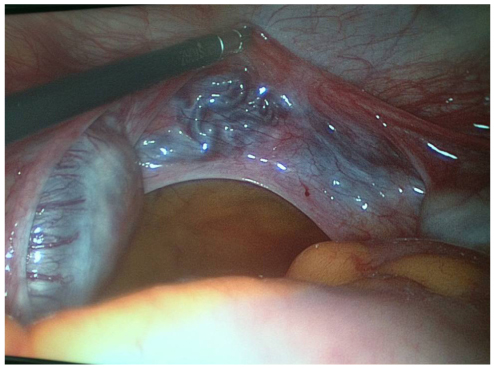Korean J Obstet Gynecol.
2012 Dec;55(12):1039-1042. 10.5468/KJOG.2012.55.12.1039.
A case of resistant ovary syndrome
- Affiliations
-
- 1Department of Obstetrics and Gynecology, Busan Paik Hospital, Inje University College of Medicine, Busan, Korea. kbdlee@hanmail.net
- 2Paik Institute for Clinical Research, Inje University, Busan, Korea.
- KMID: 2274222
- DOI: http://doi.org/10.5468/KJOG.2012.55.12.1039
Abstract
- A 21-year-old female with primary amenorrhea, sexual infantilism, and phenotypic female visited our Obstetrics and Gynecology Clinics. The patient showed elevated follicle stimulating hormone and luteinizing hormone, decreased estradiol, normal thyroid-stimulating hormone and prolactin level that means hypergonadotropic hypogonadism with normal 46, XX karyotype. Under diagnostic laparoscopy, both ovaries were intact morphology, small but anatomically normal uterus and vagina. Ovarian biopsy was taken and reported abundant primodial follicles and sporadic preantral follicles. We concluded that final diagnosis is resistant ovarian syndrome.
Keyword
MeSH Terms
Figure
Reference
-
1. Speroff L, Fritz MA. Clinical gynecologic endocrinology and infertility. 2011. 8th ed. Philadelphia (PA): Lippincott Williams & Wilkins.2. Jones GS, De Moraes-Ruehsen M. A new syndrome of amenorrhae in association with hypergonadotropism and apparently normal ovarian follicular apparatus. Am J Obstet Gynecol. 1969. 104:597–600.3. Arici A, Matalliotakis IM, Koumantakis GE, Goumenou AG, Neonaki MA, Koumantakis EE. Diagnostic role of inhibin B in resistant ovary syndrome associated with secondary amenorrhea. Fertil Steril. 2002. 78:1324–1326.4. Luborsky J. Ovarian autoimmune disease and ovarian autoantibodies. J Womens Health Gend Based Med. 2002. 11:585–599.5. Di Pasquale E, Rossetti R, Marozzi A, Bodega B, Borgato S, Cavallo L, et al. Identification of new variants of human BMP15 gene in a large cohort of women with premature ovarian failure. J Clin Endocrinol Metab. 2006. 91:1976–1979.6. Uhlenhaut NH, Treier M. Foxl2 function in ovarian development. Mol Genet Metab. 2006. 88:225–234.7. Lussiana C, Guani B, Mari C, Restagno G, Massobrio M, Revelli A. Mutations and polymorphisms of the FSH receptor (FSHR) gene: clinical implications in female fecundity and molecular biology of FSHR protein and gene. Obstet Gynecol Surv. 2008. 63:785–795.8. Aittomäki K, Lucena JL, Pakarinen P, Sistonen P, Tapanainen J, Gromoll J, et al. Mutation in the follicle-stimulating hormone receptor gene causes hereditary hypergonadotropic ovarian failure. Cell. 1995. 82:959–968.9. Layman LC, Amde S, Cohen DP, Jin M, Xie J. The Finnish follicle-stimulating hormone receptor gene mutation is rare in North American women with 46,XX ovarian failure. Fertil Steril. 1998. 69:300–302.10. Mueller A, Berkholz A, Dittrich R, Wildt L. Spontaneous normalization of ovarian function and pregnancy in a patient with resistant ovary syndrome. Eur J Obstet Gynecol Reprod Biol. 2003. 111:210–213.11. Zielińska D, Rzepka-Górska I. Pregnancy in a patient with resistant ovary syndrome: a case report. Ginekol Pol. 2011. 82:785–787.12. Atsma F, Bartelink ML, Grobbee DE, van der Schouw YT. Postmenopausal status and early menopause as independent risk factors for cardiovascular disease: a meta-analysis. Menopause. 2006. 13:265–279.13. Effects of hormone replacement therapy on endometrial histology in postmenopausal women. The Postmenopausal Estrogen/Progestin Interventions (PEPI) Trial. JAMA. 1996. 275:370–375.
- Full Text Links
- Actions
-
Cited
- CITED
-
- Close
- Share
- Similar articles
-
- Medical diagnosis and treatment of polycystic ovary syndrome
- Inter-ovarian differences in ultrasound markers of ovarian size in women with polycystic ovary syndrome
- A Case of Massive Edema of the Ovary
- Studies on Fibrinolytic System Behavior in Women with Polycystic Ovary Syndrome
- Idiopathic Intracranial Hypertension in Patient with Polycystic Ovary Syndromes



